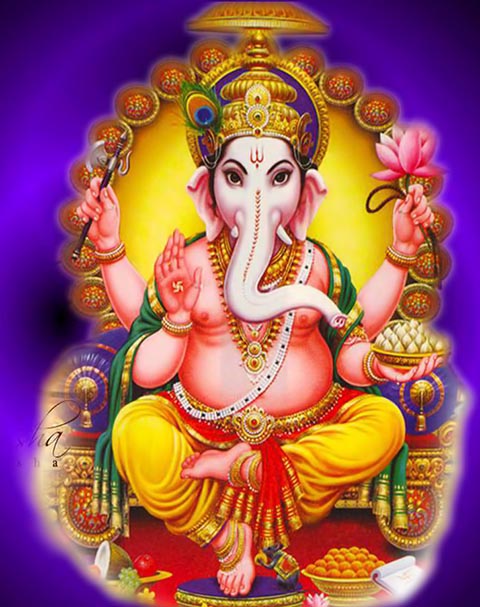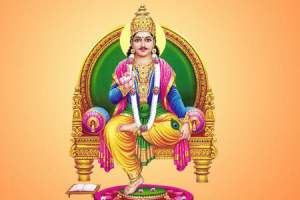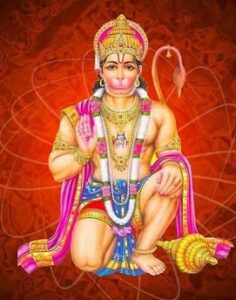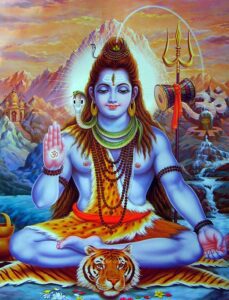Ganesha is elephant headed Hindu deity riding a mouse. Lord Ganesha has head of a elephant but body of a human form. Hindus worship lord Ganesha before starting any activity whether it is related to business, education, religious worshipping, spiritual activity or any worldly activity as it is believed that power of the Supreme lord Ganesha will remove obstacles and ensure success in their endeavours. Ganesha also worshipped as the god of education, knowledge, wisdom and wealth.
Ganesha also known as as Ganapati, Vinayaka , Vighnavinashaka, Gajanana and Pillaiyar . His image is found throughout India and Nepal. Devotion to Ganesha is widely diffused and extends to Jains, Buddhists, and beyond India.
Significance of the Ganesha Form
 The portrayal of Lord Ganesha as the blend of human and animal parts symbolizes the ideals of perfection as conceived by Hindu sages and illustrates some philosophical concepts of profound spiritual significance.
The portrayal of Lord Ganesha as the blend of human and animal parts symbolizes the ideals of perfection as conceived by Hindu sages and illustrates some philosophical concepts of profound spiritual significance.
Elephant head, wide mouth, and large ears: the large head of an elephant symbolizes wisdom, understanding, and a discriminating intellect that one must possess to attain perfection in life. The wide mouth represents the natural human desire to enjoy life in the world. The large ears signify that a perfect person is the one who possesses a great capacity to listen to others and assimilate ideas.
The trunk and two tusks with the left tusk broken: there is no known human instrument that has an operating range as wide as that of an elephant’s trunk. It can uproot a tree and yet lift a needle off the ground. Likewise, the human mind must be strong enough to face the ups and downs of the external world and yet delicate enough to explore the subtle realms of the inner world. The two tusks denote the two aspects of the human personality, wisdom and emotion. The right tusk represents wisdom and the left tusk represents emotion. The broken left tusk conveys the idea that one must conquer emotions with wisdom to attain perfection.
Elephant eyes: the elephant eyes are said to possess natural deceptiveness that allows them to perceive objects to be bigger than what they really are. Thus the elephant eyes symbolize the idea that even if an individual gets “bigger and bigger” in wealth and wisdom, he should perceive others to be bigger than himself; that is, surrender one’s pride and attain humility.
The four arms and various objects in the four hands: the four arms indicate that the Lord is omnipresent and omnipotent. The left side of the body symbolizes emotion and the right side symbolizes reason. An axe in the upper left hand and a lotus in the upper right hand signify that in order to attain spiritual perfection, one should cut worldly attachments and conquer emotions. This enables one to live in the world without being affected by earthly temptations, just as a lotus remains in water but is not affected by it. A tray of Laddus (a popular sweet indian snack) near the Lord denotes that He bestows wealth and prosperity upon His devotees. The lower right hand is shown in a blessing pose, which signifies that Ganesha always blesses His devotees.
A human body with a big belly: the human body possesses a human heart, which is a symbol of kindness and compassion toward all. Ganesha’s body is usually portrayed wearing red and yellow clothes. Yellow symbolizes purity, peace and truthfulness. Red symbolizes the activity in the world. These are the qualities of a perfect person who performs all duties in the world, with purity, peace, and truthfulness. The big belly signifies that a perfect individual must have a large capacity to face all pleasant and unpleasant experiences of the world.
A mouse sitting near the feet of Ganesha and gazing at the tray of Laddus: a mouse symbolizes the ego that can nibble all that is good and noble in a person. A mouse sitting near the feet of Ganesha indicates that a perfect person is one who has conquered his (or her) ego. A mouse gazing at the Laddus, but not consuming them, denotes that a purified or controlled ego can live in the world without being affected by the worldly temptations. The mouse is also the vehicle of Ganesha, signifying that one must control ego in order for wisdom to shine forth.
Right foot dangling over the left foot: as stated above, the left side of the body symbolizes emotion and the right side symbolizes reason and knowledge. The right foot dangling over the left foot illustrates that in order to live a successful life one should utilize knowledge and reason to overcome emotions.
Story of Elephant head Lord Ganesha
At birth, Ganesha was a perfectly normal boy, with perfect features and body parts, as befits one conceived by a goddess. According to Hindu mythology, once goddess Parvati, while bathing, created a boy out of the dirt of her body and assigned him the task of guarding the entrance to her bathroom. When Shiva, her husband returned, he was surprised to find a stranger denying him meet Parvati. He protested that no-one had the right to keep him away from his rightful wife but Ganesha did not budge from his post saying that he would not disobey his mother’s instructions. Shiva, hot-tempered as he was, flew into a terrific rage and attacked Lord Ganesha and struck off the boy’s head in rage. When Parvati came out she broke down in utter grief and to soothe her, Shiva sent out his disciples (ganas) to bring the head of any sleeping creature that was facing the north. The Ganas found a sleeping elephant and brought back its severed head, which was then attached to the body of the boy. Shiva restored its life and made him the leader (pati) of his troops. Hence, is also known as ‘Ganapati‘. Shiva also bestowed a boon that people would worship him and invoke his name before undertaking any venture.
There is another popular story behind elephant head of lord Ganesha. Goddess Parvati was so pleased at his birth and so proud of his beauty that she invited all the gods and goddesses to come to Kailash and admire him. All the celestial beings came and admired and blessed the boy except Shani (Saturn), Parvati‘s own brother. This was because Shani had been cursed by his wife and the impact of the curse was that as soon as he looked at someone that person was instantly reduced to ashes. Shani was reluctant to cause harm to his own sister’s newborn baby but Parvati was feeling so engrossed in happiness that she pleaded with Shani to see her son at least once. To please his sister Shani took his newborn nephew in his arms and hesitatingly looked at him once. One look was enough to do the damage and Ganesha’s head flew off as soon as Shani looked at him. Parvati started crying bitterly but Brahma, who was present at this time, comforted her and said that if the head of the first creature that was found would be cut off and transplanted on Ganesha’s neck he would live. So Lord Vishnu, who was also present, set off in search of any animal he may find. He had to travel all the way down Mount Kailash before, at the foothills, he found an elephant dozing on a riverbank. He immediately cut off the elephant’s head and came back.Thus, this is how Ganesha got his pachyderm head. That he is pot-bellied is not a sign of any particular ugliness. The Hindu idea of beauty portrays both men and women with pot-bellies as these are signs of well-fed prosperity.
Ganesha Chaturthi- The Birthday of Lord Ganesha
 Ganeshs chaturthi is great Ganesha festival, also known as ‘Vinayak Chaturthi‘ or ‘Vinayaka Chavithi‘ is celebrated by Hindus around the world as the birthday of Lord Ganesha. It is observed during the Hindu month of Bhadra (mid-August to mid-September) and the grandest and most elaborate of them, especially in the western India state of Maharashtra, lasts for 10 days, ending on the day of ‘Ananta Chaturdashi‘.
Ganeshs chaturthi is great Ganesha festival, also known as ‘Vinayak Chaturthi‘ or ‘Vinayaka Chavithi‘ is celebrated by Hindus around the world as the birthday of Lord Ganesha. It is observed during the Hindu month of Bhadra (mid-August to mid-September) and the grandest and most elaborate of them, especially in the western India state of Maharashtra, lasts for 10 days, ending on the day of ‘Ananta Chaturdashi‘.
A life-like clay model of Lord Ganesha is made 2-3 months prior to the day of Ganesh Chaturthi. The size of this idol may vary from 3/4th of an inch to over 25 feet.
On the day of the festival, it is placed on raised platforms in homes or in elaborately decorated outdoor tents for people to view and pay their homage. The priest, usually clad in red silk dhoti and shawl, then invokes life into the idol amidst the chanting of mantras. This ritual is called ‘pranapratishhtha‘. After this the ‘shhodashopachara‘ (16 ways of paying tribute) follows. Coconut, jaggery, 21 ‘modakas‘ (rice flour preparation), 21 ‘durva‘ (trefoil) blades and red flowers are offered. The idol is anointed with red unguent or sandal paste (rakta chandan). Throughout the ceremony, Vedic hymns from the Rig Veda and Ganapati Atharva Shirsha Upanishad, and Ganesha stotra from the Narada Purana are chanted.
For 10 days, from Bhadrapad Shudh Chaturthi to the Ananta Chaturdashi, Ganesha is worshipped. On the 11th day, the image is taken through the streets in a procession accompanied with dancing, singing, to be immersed in a river or the sea symbolizing a ritual see-off of the Lord in his journey towards his abode in Kailash while taking away with him the misfortunes of all man. All join in this final procession shouting “Ganapathi Bappa Morya, Purchya Varshi Laukariya” (O father Ganesha, come again early next year). After the final offering of coconuts, flowers and camphor is made, people carry the idol to the river to immerse it.
The whole community comes to worship Ganesha in beautifully done tents. These also serve as the venue for free medical checkup, blood donation camps, charity for the poor, dramatic performances, films, devotional songs, etc. during the days of the festival.


